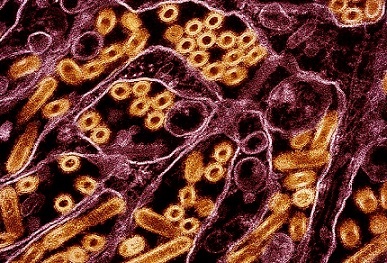Another herd affected in Michigan brings total number of dairy herds infected with H5N1 across 14 states in America to 305
Nikhil Prasad Fact checked by:Thailand Medical News Team Oct 17, 2024 6 months, 1 week, 1 day, 15 hours, 33 minutes ago
Medical News: Michigan Reports New Dairy Herd Infected by Avian Flu
In a troubling development, the Michigan Department of Agriculture and Rural Development (MDARD) has confirmed another outbreak of the highly pathogenic avian flu, H5N1, in dairy cattle. This marks Michigan's 30th outbreak, with the latest case surfacing at a dairy farm in Clinton County, near Lansing. Testing at the Michigan State University Veterinary Diagnostic Laboratory identified the virus, with further confirmation tests being sent to the U.S. Department of Agriculture (USDA) National Veterinary Services Laboratory.
 Another herd affected in Michigan brings total number of dairy herds
Another herd affected in Michigan brings total number of dairy herds
infected with H5N1 across 14 states in America to 305
If this latest case is confirmed as H5N1, the total number of avian flu outbreaks in dairy herds across 14 U.S. states will rise to 306.
https://www.aphis.usda.gov/livestock-poultry-disease/avian/avian-influenza/hpai-detections/hpai-confirmed-cases-livestock
This
Medical News report highlights the growing concern of H5N1 spreading among animals and, potentially, to humans.
Avian Flu in Dolphins: A Surprising Development
The USDA's Animal and Plant Health Inspection Service has also reported additional detections of H5N1 in bottlenose dolphins from Florida. Three dolphins from Brevard County, tested in December and January, were confirmed to carry the virus. These are the first cases in U.S. dolphins since 2022, when a bottlenose dolphin in Florida's Dixie County was infected.
The H5N1 strain, known as clade 2.3.4.4b, has been identified in various mammal species, including seals, sea lions, and now dolphins, raising concerns about the virus's impact on marine life. While avian flu typically spreads among birds, these findings show the virus can jump species, affecting sea mammals as well.
H5N1: A Growing Threat to Public Health
The year 2024 has seen a total of 25 human cases of H5 in the United States, with 16 confirmed as H5N1. The virus seems to spread primarily through contact with infected animals.
California leads with 11 human cases, followed by Colorado with 10.
https://www.cdc.gov/bird-flu/situation-summary/index.html
Michigan has also reported two cases in humans, although no widespread flu indicators have been found among the general population.
The Centers for Disease Control and Prevention (CDC) has reassured the public that, despite the rise in animal cases, there is no evidence of unusual influenza activity in people, including those infected with H5N1. The CDC continues to monitor the situation closely, updating their data regularly to keep t
he public informed.
Conclusion
The spread of H5N1 is becoming a serious issue in the U.S., affecting both farm animals and wildlife. With over 300 dairy herd outbreaks in 14 states and new cases in dolphins, the virus is showing its capacity to infect multiple species. The link between these infections and human cases is being monitored, though no major human outbreaks have occurred so far. The CDC and USDA are working to control the situation through continuous testing and surveillance, ensuring public health safety remains a top priority.
As the virus continues to affect both land and marine animals, the potential for more cases in humans cannot be ruled out. The public should remain aware and informed, especially those in areas where avian flu outbreaks are being reported.
For the latest updates and developments on this ongoing health threat, keep logging on to Thailand
Medical News.
Read Also:
https://www.thailandmedical.news/news/japan-on-alert-as-h5n1-virus-infects-wild-ducks-and-falcons-in-hokkaido
https://www.thailandmedical.news/news/california-h5n1-updates-6-humans-infected-100-dairy-herds-affected,-dead-cows-now-being-dumped-on-roadsides
